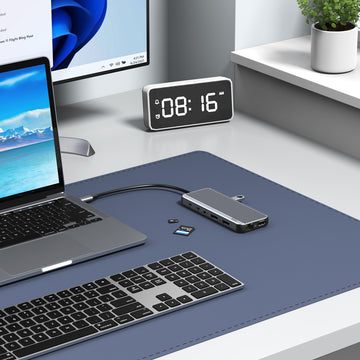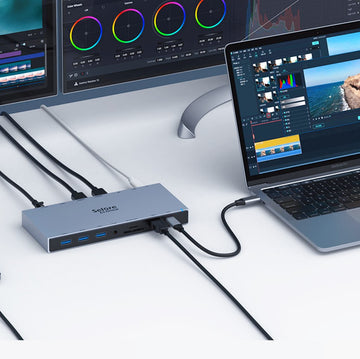Seamless Connectivity and Beyond: Exploring the World of Docking Stations
What is a Docking Station?
A docking station is a device designed to expand the functionality of a laptop or computer, optimizing your workstation. It typically provides additional ports or functions not available on the laptop or computer itself. You can easily connect peripherals such as monitors, keyboards, mice, printers, external storage devices, and more to your device. Docking stations often offer a variety of ports, including USB, HDMI, DisplayPort, audio jacks, Ethernet ports for wired internet connectivity, and sometimes even charging function. As an ideal solution, it creates a more versatile workspace for individuals. And it is especially helpful in reducing cable clutter around your laptop.
A docking station is an integrated solution that offers a centralized hub where various peripherals can be connected. By providing additional ports and connections, a docking station eliminates the need for multiple cables and adapters, simplifying the process of connecting and disconnecting devices. Whether you're in the office, at home, or on the go, a docking station is a versatile solution for extending the functionality of your device. A port replicator is an external device that connects to peripherals through ports built into the device. Mobile users access peripherals by connecting the port replicator to a USB port or a special port on your device. A docking station is similar to a port replicator, but it offers more features. A docking station is more than a port replicator, it typically includes a power connection and offers a wider range of connectivity options. In addition to peripheral connections, a docking station often features slots for memory cards, hard drives, and other devices. Users can utilize a full-sized keyboard, a mouse, and other desktop peripherals. The main difference between a port replicator and a docking station is that the former provides peripheral connections through built-in ports on the device, while the latter offers additional functionality.
One of the drawbacks of laptops with limited peripheral ports is that connection options are restricted. With a limited number of ports available, users may have difficulty in connecting multiple peripherals simultaneously. This can lead to the need for additional adapters or hubs to accommodate all the desired devices, which can add complexity and clutter to the setup. Another disadvantage is the inconvenience of frequently plugging and unplugging peripheral devices. For example, if a user needs to switch between a mouse, keyboard, external monitor, and other devices, the process of disconnecting and reconnecting cables can be time-consuming. Limited ports can also impact productivity and efficiency. Users may need to alternate between different peripherals, such as swapping between a printer and an external hard drive, which can slow down tasks and hinder multitasking capabilities. Additionally, if a laptop lacks specific ports, such as an Ethernet port for wired internet connectivity, users may need to rely on slower wireless connections or invest in additional accessories. Overall, the limited number of ports on laptops can restrict the flexibility of connecting peripherals, and impacting productivity for users who rely on multiple devices at the same time. Multiple ports are for enhanced functionality, including connecting external monitors and charging.
Docks enable more connection of peripherals to your laptop. As laptops have become smaller and lighter, there are fewer ports available. When working with a laptop, individuals often need more additional devices connected. USB C is a universal port that is capable of accommodating external storage, external displays, and power delivery. Thunderbolt 3 and Thunderbolt 4 are more advantageous, with faster data transfer than standard USB C. Overall, docking stations bridge the gap between laptops and desktops by providing massive connections. They feature an upgraded experience, simplified connectivity, power and charging capabilities, and the flexibility to switch between mobility and a full workstation. It is much easier for users to adjust workstation settings to their specific needs and preferences.
Remote work refers to the practice of working outside of a traditional office environment, often from home or other locations away from the central workplace. We all know the advantages of remote work. It has become increasingly popular in recent years, offering flexibility and the ability to work from anywhere with an internet connection. Working from home can facilitate a work-life harmony, enhance productivity, and give you comfortable work environment. Remote work also contributes to skill development. For example, You may acquire proficiency in utilizing technologies such as cloud computing, virtual meeting platforms, and digital communication tools. When it comes to remote work, a docking station can be a valuable tool for balancing between portability and connectivity for employees.
How Does a Docking Station Work?
The difference between USB C hubs and docking stations is negligible. Both of them are intended to expand peripheral connections. USB C hubs primarily serve to enlarge the quantity of USB A ports on a laptop and are usually powered by the laptop itself. Reliable hubs are usually compact and lightweight to align with the laptop, making them an ideal choice for professionals who frequently travel. Docking stations are more advanced than USB C hubs but are generally less portable and more costly. They provide a variety of ports for diverse peripherals in creating a multi-functional work center, supporting monitor extension (video ports include HDMI, DisplayPort, mini-DisplayPort, VGA, and DVI), Gigabit Ethernet, audio connections, SD/Micro SD card readers, and a lot of USB A or USB C devices. Docking stations can power all these devices at once, along with your laptop. Docking stations usually obtain power through a power outlet.Docking stations play a crucial role in providing a desktop experience for laptop users. They enhance the desktop experience for laptop users by supporting multiple monitors, improving ergonomics, providing power delivery, and simplifying cable management. They transform laptops into multi-functional workstations that closely resemble traditional desktop setups, improving productivity, comfort and convenience.
How to Choose a Docking Station?
There are several important factors to consider before purchasing a laptop docking station. Choosing the laptop docking station that best meets your needs ensures compatibility and optimal functionality for your specific setup.Compatibility:
The docking station should work with your laptop's ports and operating system. First check the specifications to make sure the docking station supports your laptop model. Pay attention to all ports of your laptop (e.g. USB C, Thunderbolt 3).Specific Needs:
Consider the number and types of all ports available for peripheral connections, such as USB A ports, USB C ports, HDMI, DisplayPort, VGA, Ethernet ports for internet access, audio jacks, SD/Micro card reader, and any additional ports you require. Ensure that the docking station provides enough options to support your workflow. Think about any additional features or functionalities that are important to you. For example, importance of video and audio output quality for work needs.
Power Delivery:
Check if the dock supports power delivery before making a final decision. Find out the maximum power of the docking station and ensure it is sufficient to charge your laptop. Consider the power requirements of your laptop, especially if you have a power-hungry device or multiple peripherals that need power.Display Support:
If you intend to connect multiple monitors, check the display support capability of the docking station. Verify the maximum resolution and refresh rate supported by the docking station. Some docking stations support multi-monitor setups, so select your desired monitor configuration.Product Design:
Look for a high-quality and well-built adapter that can withstand regular use. Horizontal and vertical design options are available according to personal preference. Horizontal design docking stations sit flat on the desktop, similar to a small box. This type is often wider and longer, providing a stable base for laptops and peripherals. Ports of horizontal docking stations are usually located on the back or side for easy access and cable management. They are usually more common and widely available. Vertical docking stations stand upright and take up less space compared to horizontal docking stations. Choosing between horizontal and vertical design options depends on personal preference, available desk space, number of peripherals, and overall aesthetics.Price:
Compare the prices of different docking stations within your budget. Consider features, quality, and compatibility to determine. Balance your requirements and costs to find the right one.Installation:
Some docking stations may require install specific drivers or software to enable all the features and functions. Check the manufacturer's website or the documentation provided. For convenience, choose one that is easy to install and use as much as possible.FAQ about Laptop Docking Station
Is a Laptop Docking Station Worth Buying?
It's certainly a worthwhile choice, particularly for individuals who frequently handle multiple devices. A docking station allows users to create an efficient work center. Therefore, it is highly recommended to invest in an affordable and excellent docking station.Do You Need a Docking Station for Multiple Monitors?
A multi-monitor docking station is very beneficial if you seek productivity. It enables you to connect external screens to your laptop, maximizing work efficiency. Additionally, it supports fast data transfer between different hardware devices and additional USB ports.What Devices Can Connect to the Docking Station?
Multiple monitors, external USB storage, wired network connections, keyboards, mice, webcams, audio devices, and more.Can You Connect Any Laptop to a Docking Station?
Please note that not all laptops and docking stations are compatible with each other. It is crucial to check the compatibility before using a docking station. Make sure that it supports your laptop's operating system and model to avoid any potential issues.Conclusion
Docking stations serve as valuable tools that boost productivity. They make the computing experience more efficient and organized by connecting more peripherals. Docking stations work as an optimal solution to enhance your overall efficiency and workflow. In additional, docking stations are essential tools in remote work setups and contribute to a more productive remote work experience.
Making an informed choice when selecting a docking station ensures compatibility, functionality, performance and reliability. And it helps you get a cost-effective docking station. By carefully evaluating your needs and conducting thorough research, you can select the docking station that best suits your requirements, enhancing your overall work experience. It would be better to read customer reviews and compare various models in order to make an well-informed choice. We hope this blog will provide assistance for you in choosing the perfect docking station.
Take Selore 15 IN 1 USB C Docking Station as an example, the 15-in-1 docking station works perfectly with both Windows and macOS systems, and is compatible with a wide range of laptops and Thunderbolt 3 devices. With dual 4K HDMI ports, it expands your USB C laptop's display for a stunning visual experience. Super-speed USB 3.1 ports deliver fast data transfer at speeds of up to 10Gbps, allowing for seamless connectivity with peripherals. Keep your laptop powered up while connecting multiple devices through the 100W Power Delivery Type C port. The 3.5mm Audio & Mic Jack enhances your audio experience, and and SD and Micro SD card readers transfer videos or photos quickly.
